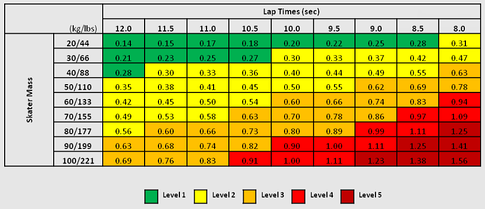
Given the sheer speed of short track speed skating events, it is no surprise that the risk for injury for participants in this sport can be high at times. In the province of Quebec alone, there had been over 280 injuries reported between 2009 and 2011 on short track speed skating rinks.
These findings have caused Speed Skating Canada to re-evaluate the safety guidelines with regards to speed skating protective padding as of late. In doing so, they have now established a minimum padding standard for both practice and competition speed skating events.
Much the same as the guidelines for long track speed skating padding requirements; all specifications are based on a mathematical formula:
Kinetic Energy Factor (KEF) = (skater mass in kg)/(fastest expected lap time in seconds)²
Below you will find the Short Track KEF Values thanks to Speed Skating Canada:

While Speed Skating Canada believes this should curb injuries quite drastically, athletes and skaters should never be too cautious about their safety, and that it goes far beyond the padding set up to protect them.
Here are a few other suggestions they make to skaters:
Reduce Speed Prior to Impact
Simply stating the more time a skater can spend sliding on the ice before impact, the better. The friction of the often “rough” ice surface will help reduce the speed before impact.
Hit the Boards Properly
Training programs and coaches are now teaching their skaters how to properly fall into the boards, preferably feet first, saving the devastating injury that could occur when going head first into the boards.
Thicker Pads
They use this as a sound principle: no padding is too much padding. Increased padding should by all means absorb more impact energy, usually done by either replacing existing pads with a thicker pad or doubling up thin pads.
Foam Type
Firmer pads are recommended along straightaways, allowing participants to safely bounce off the pads and continue the race. For the remainder of the rink, it can become slightly more complicated. The rule of thumb is a combination of both firm and softer padding along the rest of the rink. Coming into a corner, a skater has a lot of momentum behind them, and injury could easily take place even with firm padding. It is recommended to use a softer padding in front of a firmer pad in cornered areas to help reduce the risk of injury.
We at Sport Systems specialize in custom safety padding, and have experience designing, manufacturing and installing a variety of safety padding projects across a wide variety of applications. Feel free to contact our sales team for a consultation, or download our Custom Padding Guide and Request a Quote today!
For more information about Speed Skating Canada’s Safety Guidelines, please visit their website at www.speedskating.ca
.png)

